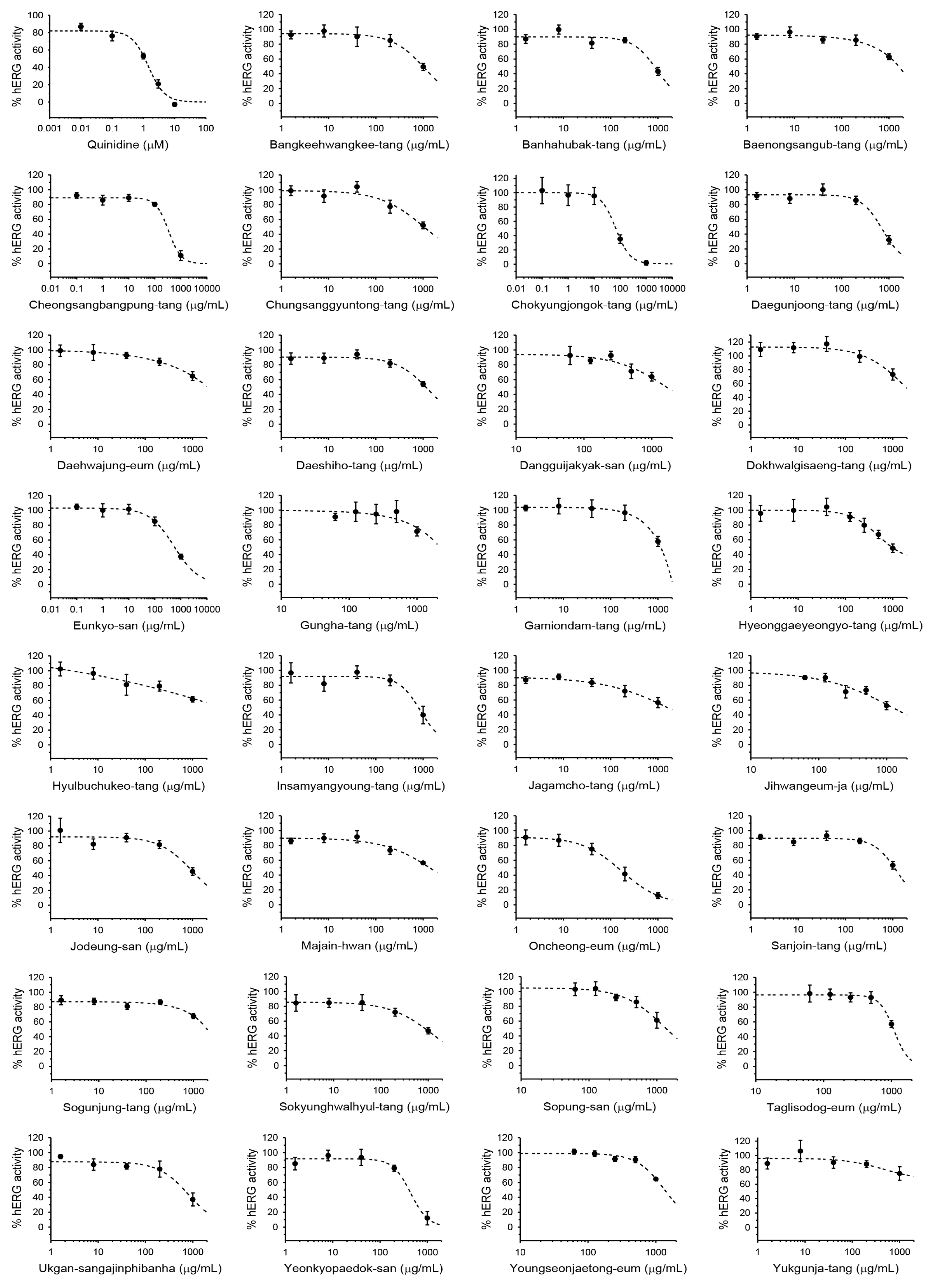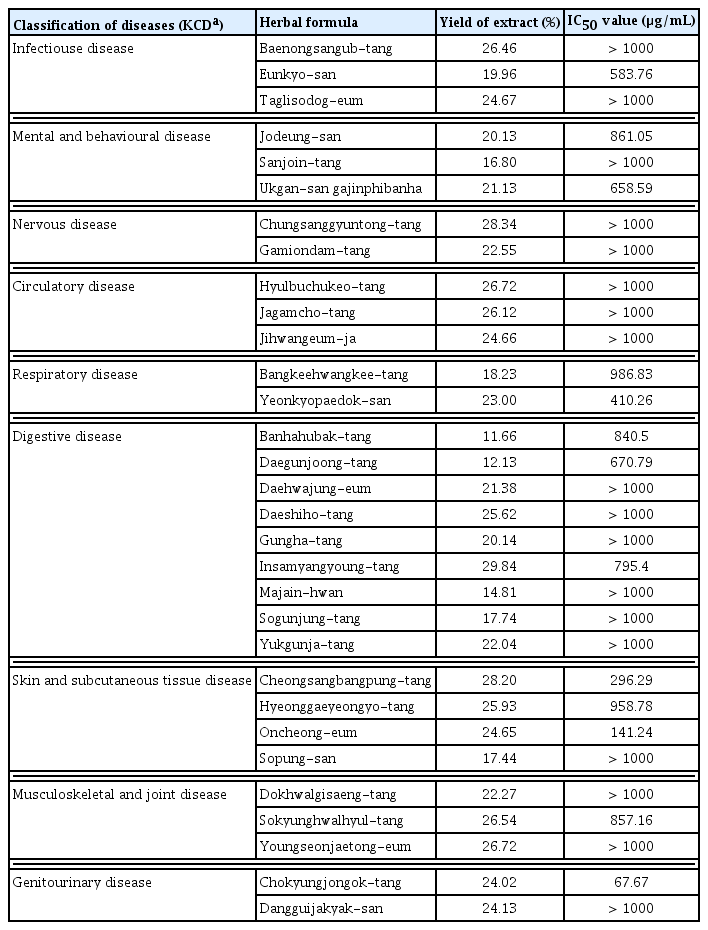| Baenongsangub-tang |
Chunlimheonbangham |
Ponciri Fructus Immaturus (16.67%), Paeoniae Radix (16.67%), Platycodonis Radix (16.67%), Glycyrrhizae Radix et Rhizoma (16.67%), Zingiberis Rhizoma (16.67%), Zizyphi Fructus (16.67%) |
| Bangkeehwangkee-tang |
Geumgweyolyag |
Sinomeni Caulis et Rhizoma (24.39%), Astragali Radix (24.39%), Atractylodis Rhizoma Alba (14.63%), Zingiberis Rhizoma Recens (7.32%), Zizyphi Fructus (19.51%), Glycyrrhizae Radix et Rhizoma (9.76%) |
| Banhahubak-tang |
Bangyaghabpyeon |
Pinelliae Tuber (28.30%), Poria Sclerotium (22.64%), Magnoliae Cortex (16.98%), Perillae Folium (11.32%), Zingiberis Rhizoma (13.21%), Zizyphi Fructus (7.55%) |
| Cheongsangbangpung-tang |
Bangyaghabpyeon |
Angelicae Dahuricae Radix (10.92%), Forsythiae Fructus (10.92%), Platycodonis Radix (10.92%), Saposhnikoviae Radix (10.01%), Scutellariae Radix (9.54%), Cnidii Rhizoma (9.54%), Schizonepetae Spica (6.81%), Gardeniae Fructus (6.81%), Coptidis Rhizoma (6.81%), Aurantii Fructus Immaturus (6.81%), Menthae Herba (6.81%), Glycyrrhizae Radix et Rhizoma (4.08%) |
| Chokyungjongok-tang |
Bangyaghabpyeon |
Rehmanniae Radix Preparata (12.29%), Cyperi Rhizoma (12.29%), Angelicae Gigantis Radix (8.20%), Evodiae Fructus (8.20%), Cnidii Rhizoma (8.20%), Paeoniae Radix (6.56%), Poria Sclerotium (6.56%), Citri Unshius Pericarpium (6.56%), Corydalis Tuber (6.56%), Moutan Radicis Cortex (6.56%), Zingiberis Rhizoma (6.56%), Cinnamomi Cortex (4.09%), Artemisiae Argyi Folium (4.09%), Zingiberis Rhizoma Recens (3.28%) |
| Chungsanggyuntong-tang |
Jejungsinpyeon |
Scutellariae Radix (13.52%), Atractylodis Rhizoma (9.00%), Osterici seu Notopterygii Radix et Rhizoma (9.00%), Araliae Continentalis Radix (9.00%), Saposhnikoviae Radix (9.00%), Cnidii Rhizoma (9.00%), Angelicae Gigantis Radix (9.00%), Angelicae Dahuricae Radix (9.00%), Liriopis seu Ophiopogonis Tuber (9.00%), Viticis Fructus (4.51%), Chrysanthemi Indici Flos (4.51%), Chrysanthemi Indici Flos (2.71%), Glycyrrhizae Radix et Rhizoma (2.71%) |
| Daegunjoong-tang (without Oryzae gluten) |
Geumgweyolyag |
Zingiberis Rhizoma (50.00%), Ginseng Radix (25.00%), Zanthoxyli Pericarpium (25.00%) |
| Daehwajung-eum |
Bangyaghabpyeon |
Crataegi Fructus (19.99%), Hordei Fructus Germinatus (19.99%), Citri Unshius Pericarpium (15.01%), Magnoliae Cortex (15.01%), Alismatis Rhizoma (15.01%), Ponciri Fructus Immaturus (9.99%), Amomi Fructus (5.01%) |
| Daeshiho-tang |
Bangyaghabpyeon |
Bupleuri Radix (29.62%), Scutellariae Radix (18.52%), Paeoniae Radix (18.52%), Rhei Radix et Rhizoma (14.81%), Ponciri Fructus Immaturus (11.12%), Pinelliae Tuber (7.41%) |
| Dangguijakyak-san |
Geumgweyolyag |
Paeoniae Radix (18.18%), Alismatis Rhizoma (18.18%), Atractylodis Rhizoma Alba (18.18%), Poria Sclerotium (18.18%), Angelicae Gigantis Radix (13.64%), Cnidii Rhizoma (13.64%) |
| Dokhwalgisaeng-tang |
Donguibogam |
Araliae Continentalis Radix (8.24%), Angelicae Gigantis Radix (8.24%), Paeoniae Radix (8.24%), Loranthi Ramulus et Folium (8.24%), Rehmanniae Radix Preparata (5.88%), Cnidii Rhizoma (5.88%), Ginseng Radix (5.88%), Poria Sclerotium (5.88%), Achyranthis Radix (5.88%), Eucommiae Cortex (5.88%), Gentianae Macrophyllae Radix (5.88%), Asiasari Radix et Rhizoma (5.88%), Saposhnikoviae Radix (5.88%), Cinnamomi Cortex (5.88%), Glycyrrhizae Radix et Rhizoma (3.52%), Zingiberis Rhizoma (4.72%) |
| Eunkyo-san |
Onbyeongjobyeon |
Forsythiae Fructus (17.86%), Lonicerae Flos (17.86%), Arctii Fructus (10.71%), Platycodonis Radix (10.71%), Menthae Herba (10.71%), Glycine Semen Preparata (8.93%), Folium Phyllostachydis (7.14%), Schizonepetae Spica (7.14%), Glycyrrhizae Radix et Rhizoma (8.93%) |
| Gamiondam-tang |
Bangyaghabpyeon |
Cyperi Rhizoma (23.23%), Citri Unshius Pericarpium (11.61%), Pinelliae Tuber (7.74%), Ponciri Fructus Immaturus (7.74%), Phyllostachyos Caulis in Taeniam (7.74%), Ginseng Radix (5.81%), Poria Sclerotium (5.81%), Bupleuri Radix (5.81%), Liriopis seu Ophiopogonis Tuber (5.81%), Platycodonis Radix (5.81%), Glycyrrhizae Radix et Rhizoma (3.87%), Zingiberis Rhizoma Recens (3.87%), Zizyphi Fructus (5.16%) |
| Gungha-tang |
Bangyaghabpyeon |
Cnidii Rhizoma (17.64%), Pinelliae Tuber (17.64%), Poria Sclerotium (17.64%), Citri Unshius Pericarpium (8.84%), Citri Unshius Pericarpium Immaturus (8.84%), Aurantii Fructus Immaturus (8.84%), Atractylodis Rhizoma Alba (4.37%), Glycyrrhizae Radix et Rhizoma (4.42%), Zingiberis Rhizoma Recens (11.76%) |
| Hyeonggaeyeongyo-tang |
Bangyaghabpyeon |
Schizonepetae Spica (7.86%), Forsythiae Fructus (7.86%), Saposhnikoviae Radix (7.86%), Angelicae Gigantis Radix (7.86%), Cnidii Rhizoma (7.86%), Bupleuri Radix (7.86%), Aurantii Fructus Immaturus (7.86%), Scutellariae Radix (7.86%), Angelicae Dahuricae Radix (7.86%), Platycodonis Radix (7.86%), Paeoniae Radix (7.86%), Gardeniae Fructus (7.86%), Glycyrrhizae Radix et Rhizoma (5.62%) |
| Hyulbuchukeo-tang |
Uilimgaechag |
Persicae Semen (15.79%), Carthami Flos (11.84%), Angelicae Gigantis Radix (11.84%), Rehmanniae Radix Recens (11.84%), Achyranthis Radix (11.84%), Aurantii Fructus Immaturus (7.89%), Paeoniae Radix (7.89%), Cnidii Rhizoma (6.58%), Platycodonis Radix (6.58%), Bupleuri Radix (3.95%), Glycyrrhizae Radix et Rhizoma (3.95%) |
| Insamyangyoung-tang |
Bangyaghabpyeon |
Paeoniae Radix (15.77%), Angelicae Gigantis Radix (7.89%), Ginseng Radix (7.89%), Atractylodis Rhizoma Alba (7.89%), Astragali Radix (7.89%), Cinnamomi Cortex (7.89%), Citri Unshius Pericarpium (7.89%), Glycyrrhizae Radix et Rhizoma (7.89%), Rehmanniae Radix Preparata (5.91%), Schisandrae Fructus (5.91%), Saposhnikoviae Radix (5.91%), Polygalae Radix (3.93%), Zingiberis Rhizoma Recens (3.15%), Zizyphi Fructus (4.21%) |
| Jagamcho-tang |
Donguibogam |
Glycyrrhizae Radix et Rhizoma (17.43%), Rehmanniae Radix (13.09%), Cinnamomi Ramulus (13.09%), Cannabis Semen (13.09%), Liriopis seu Ophiopogonis Tuber (13.09%), Ginseng Radix (8.72%), Asini Corii Colla (8.72%), Zizyphi Fructus (6.97%), Zingiberis Rhizoma (5.81%) |
| Jihwangeum-ja |
Donguibogam |
Rehmanniae Radix Preparata (8.38%), Morindae Radix (8.38%), Corni Fructus (8.38%), Dendrobii Caulis (8.38%), Cistanchis Herba (8.38%), Schisandrae Fructus (8.38%), Polygalae Radix (8.38%), Poria Sclerotium (8.38%), Liriopis seu Ophiopogonis Tuber (8.38%), Aconiti Lateralis Radix Preparata (4.18%), Acori Graminei Rhizoma (4.18%), Cinnamomi Cortex (4.18%), Menthae Herba (4.18%), Zingiberis Rhizoma Recens (3.35%), Zizyphi Fructus (4.47%) |
| Jodeung-san |
Bojebonsabang |
Gypsum Fibrosum (21.21%), Uncariae Ramulus cum Uncus (9.09%), Citri Unshius Pericarpium (9.09%), Pinelliae Tuber (9.09%), Liriopis seu Ophiopogonis Tuber (9.09%), Poria Sclerotium (9.09%), Ginseng Radix (9.09%), Saposhnikoviae Radix (9.09%), Chrysanthmi Flos (9.09%), Glycyrrhizae Radix et Rhizoma (3.03%), Zingiberis Rhizoma Recens (3.03%) |
| Majain-hwan |
Sanghanlon |
Cannabis Semen (28.99%), Magnoliae Cortex (17.39%), Armeniacae Semen (14.49%), Paeoniae Radix (13.04%), Ponciri Fructus Immaturus (13.04%), Rhei Radix et Rhizoma (13.04%) |
| Oncheong-eum |
Donguibogam |
Angelicae Gigantis Radix (12.50%), Cnidii Rhizoma (12.50%), Paeoniae Radix (12.50%), Rehmanniae Radix Preparata (12.50%), Coptidis Rhizoma (12.50%), Scutellariae Radix (12.50%), Phellodendri Cortex (12.50%), Gardeniae Fructus (12.50%) |
| Sanjoin-tang |
Geumgweyolyag |
Zizyphi Semen (53.33%), Cnidii Rhizoma (13.33%), Anemarrhenae Rhizoma (13.33%), Poria Sclerotium (13.33%), Glycyrrhizae Radix et Rhizoma (6.67%) |
| Sogunjung-tang (without Oryzae gluten) |
Donguibogam |
Paeoniae Radix (46.98%), Cinnamomi Ramulus (27.89%), Glycyrrhizae Radix et Rhizoma (9.42%), Zingiberis Rhizoma Recens (5.65%), Zizyphi Fructus (10.05%) |
| Sokyunghwalhyul-tang |
Manbyeonghoichun |
Paeoniae Radix (10.11%), Angelicae Gigantis Radix (7.87%), Achyranthis Radix (6.74%), Atractylodis Rhizoma Alba (6.74%), Clematidis Radix (6.74%), Citri Unshius Pericarpium (6.74%), Persicae Semen (6.74%), Rehmanniae Radix Recens (6.74%), Cnidii Rhizoma (5.62%), Sinomeni Caulis et Rhizoma (5.62%), Osterici seu Notopterygii Radix et Rhizoma (5.62%), Saposhnikoviae Radix (5.62%), Gentianae Scabrae Radix et Rhizoma (5.62%), Angelicae Dahuricae Radix (5.62%), Poria Sclerotium (4.49%), Glycyrrhizae Radix et Rhizoma (2.25%), Zingiberis Rhizoma Recens (1.12%) |
| Sopung-san |
Oegwajeongjong |
Schizonepetae Spica (8.33%), Angelicae Gigantis Radix (8.33%), Sophorae Radix (8.33%), Cicadidae Periostracum (8.33%), Arctii Fructus (8.33%), Gypsum Fibrosum (8.33%), Saposhnikoviae Radix (8.33%), Rehmanniae Radix (8.33%), Atractylodis Rhizoma (8.33%), Sesami Semen Nigra (8.33%), Anemarrhenae Rhizoma (8.33%), Akebiae Caulis (4.17%), Glycyrrhizae Radix et Rhizoma (4.17%) |
| Taglisodog-eum |
Bangyaghabpyeon |
Lonicerae Flos (17.65%), Citri Unshius Pericarpium (17.65%), Astragali Radix (11.76%), Trichosanthis Radix (11.76%), Saposhnikoviae Radix (5.88%), Angelicae Gigantis Radix (5.88%), Cnidii Rhizoma (5.88%), Angelicae Dahuricae Radix (5.88%), Platycodonis Radix (5.88%), Magnoliae Cortex (5.88%), Gleditsiae Spina (5.88%) |
| Ukgan-san gajinphibanha |
Boyoungchwaryo |
Bupleuri Radix (15.87%), Pinelliae Tuber (15.87%), Atractylodis Rhizoma Alba (12.70%), Poria Sclerotium (12.70%), Angelicae Gigantis Radix (9.52%), Citri Unshius Pericarpium (9.52%), Uncariae Ramulus cum Uncus (9.52%), Cnidii Rhizoma (9.52%), Glycyrrhizae Radix et Rhizoma (4.76%) |
| Yeonkyopaedok-san |
Donguibogam |
Forsythiae Fructus (7.37%), Lonicerae Flos (7.37%), Schizonepetae Spica (7.37%), Saposhnikoviae Radix (7.37%), Osterici seu Notopterygii Radix et Rhizoma (7.37%), Araliae Continentalis Radix (7.37%), Bupleuri Radix (7.37%), Cnidii Rhizoma (7.37%), Aurantii Fructus Immaturus (7.37%), Platycodonis Radix (7.37%), Poria Sclerotium (7.37%), Menthae Herba (7.37%), Glycyrrhizae Radix et Rhizoma (7.37%), Zingiberis Rhizoma Recens (4.20%) |
| Youngseonjaetong-eum |
Bangyaghabpyeon |
Ephedrae Herba (11.26%), Paeoniae Radix (11.26%), Saposhnikoviae Radix (5.62%), Schizonepetae Spica (5.62%), Osterici seu Notopterygii Radix et Rhizoma (5.62%), Araliae Continentalis Radix (5.62%), Clematidis Radix (5.62%), Angelicae Dahuricae Radix (5.62%), Atractylodis Rhizoma (5.62%), Scutellariae Radix (5.62%), Ponciri Fructus Immaturus (5.62%), Platycodonis Radix (5.62%), Puerariae Radix (5.62%), Cnidii Rhizoma (5.62%), Angelicae Gigantis Radix (3.36%), Cimicifugae Rhizoma (3.36%), Glycyrrhizae Radix et Rhizoma (3.36%) |
| Yukgunja-tang |
Bangyaghabpyeon |
Pinelliae Tuber (20.17%), Atractylodis Rhizoma Alba (20.17%), Citri Unshius Pericarpium (13.46%), Poria Sclerotium (13.46%), Ginseng Radix (13.46%), Glycyrrhizae Radix et Rhizoma (6.71%), Zingiberis Rhizoma Recens (5.38%), Zizyphi Fructus (7.18%) |



